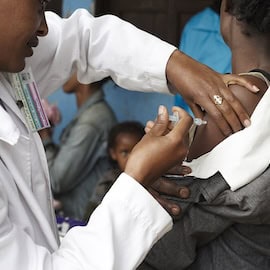In the global health community, we know that it’s a question of when, not if, there will be another pandemic. We get frequent reminders of this potential threat, most recently with the spread of avian H5N1 influenza viruses in the U.S., and the mpox outbreak that began in Africa and has now been reported in 123 countries. It is clear that we must prepare, we must invest and we must be ready.
Yet unfortunately — and perhaps understandably — this threat no longer feels urgent. People are still exhausted from fighting the COVID-19 pandemic, so they’re less receptive to calls to prepare for another one — especially alongside the growing need to address other threats, such as the global impacts of climate change and the rising dangers of antimicrobial resistance.
However, amidst this fatigue, we should also take time to celebrate the good news. Each week brings exciting developments around new vaccines, such as the recent approval of respiratory syncytial virus (RSV) vaccine, as well as new investments in vaccine manufacturing, bringing vaccine availability closer to hundreds of millions of people in lower-resourced settings. And as we saw with the COVID-19 vaccine — the fastest developed vaccine in history — mRNA vaccines could be effective against a wide variety of diseases, and they may prove to be invaluable during future epidemics and pandemics given the speed with which they can be manufactured.
But these vaccines are only life-saving if they are actually used. And one area where we continue to face challenges is in building the systems and programs to deliver these new vaccines to the people who need them. Building these systems is difficult and time-consuming, and the process is often less interesting to many than the idea of developing new vaccine technologies.
The Link Between Influenza Vaccination Programs and Pandemic Readiness
As the Director of the Partnership for International Vaccine Initiatives at The Task Force for Global Health, I lead a team that is working to bring these global health solutions to communities around the world. In our experience, countries with strong seasonal influenza vaccination programs can quickly pivot to deploying pandemic and/or epidemic vaccines, because their influenza systems have been tested and proven to be ready. Recent research supports this, with a 2024 review of COVID-19 vaccine deployment finding that countries with routine influenza vaccination programs were able to deploy COVID-19 vaccines more efficiently than countries without such programs.
Why are influenza vaccines a valuable building block for strengthening vaccine systems? First, influenza vaccines are targeted to populations — largely adults — that are often also prioritized for pandemic vaccines. This includes health workers, pregnant women, older adults and those with underlying chronic diseases, such as heart disease or diabetes. While every country in the world has a functioning program to vaccinate children, national health programs do not generally target adult populations for vaccines. These health programs have created and tested initiatives focused on childhood vaccines, developing their capacity to reach unvaccinated children, talk with them (or their parents) about vaccines, and train and deploy vaccinators to the communities where these children live. But these capabilities are often not well-established for at-risk adult populations.
Second, influenza vaccines are given annually, so influenza vaccination campaigns better mirror the logistical and communication needs of pandemic vaccination. They essentially simulate effective pandemic vaccine campaigns, allowing countries to refine their capabilities over time.
And finally, data suggest that those who receive annual influenza vaccines would be more likely to accept vaccines during emergency responses than those who don’t receive them. Recent experience from mpox vaccination efforts has shown this as well. With vaccine acceptance becoming a growing problem, especially in adults, annual influenza vaccination campaigns are an effective tool to reduce such hesitancy during pandemics, due to the regular communication they establish with the public around the value of vaccines. With all of this in mind, it is no wonder that countries with influenza vaccine programs were better able to deploy pandemic vaccines in 2009 against the H1N1 influenza pandemic and during the COVID-19 pandemic, compared to countries without such programs.
Now is the Time to Maximize the Effectiveness of Global Vaccine Systems
Now — before the next pandemic strikes — we have the opportunity to ensure that epidemic and pandemic vaccine programs targeting adults are sustained and strengthened, while not leaving out or undermining the critically important vaccination of children, on which a majority of current vaccine deployment systems focus.
We have seen that countries that lack reliable ongoing vaccination programs struggle to deploy new vaccines quickly and efficiently during crises. When systems are not in place, people die. It’s time to create and strengthen these systems — not only in preparation for future pandemics, but in response to the ongoing risk from existing diseases. Each year, influenza kills hundreds of thousands and hospitalizes millions more. There is an urgent need to use the tools that are currently available to reduce these numbers.
But how can the global health community maximize the effectiveness of these vaccination systems, at a time when pandemic preparedness is no longer the top global development priority?
We can start by focusing on health workers — an excellent first priority group for influenza vaccination. Among groups at high risk of influenza, health workers comprise a smaller group than others recommended to receive the vaccine, such as older adults and those with chronic diseases. So the investment is smaller. Vaccinating health workers protects health systems, reducing absenteeism during peak influenza seasons, and creates systems for pandemic vaccine deployment. These workers are also easily accessible, thereby reducing the cost and complexity of annual vaccination. Finally, health workers are key influencers in their communities, so as they are vaccinated, they will be more likely to recommend that their patients and loved ones also receive the vaccine. But though health workers are already at the forefront of vaccination strategies and programs in many countries, these programs are often under-resourced. We need to grow them in countries where they exist, and expand them to all countries that lack them, as a first step in strengthening these systems.
Additionally, in stabilizing, maintaining and building global vaccine delivery systems, we must be ever mindful of the struggles that many countries around the world face in ensuring that their populations are vaccinated quickly, efficiently and equitably. We must ensure that lower-resourced countries are able to balance the dual priorities of introducing new life-saving vaccines, while also focusing more resources on expanding vaccination programs that reach health workers, as these will serve as critical tools in any future pandemic response.
Because of COVID-19, for the first time in history, nearly every country in the world has a vaccination program that has the capacity to target both adults and children. We can’t lose these tremendous gains, as we move forward in protecting populations from the next pandemic.
Joseph Bresee, MD is the Director of the Partnership for International Vaccine Initiatives at The Task Force for Global Health.
Photo courtesy of UNICEF Ethiopia/2010/Gudejko.
Publisher: Source link






